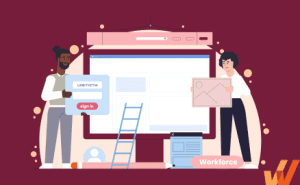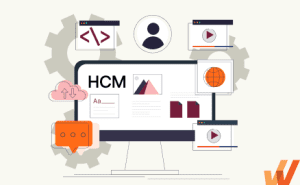
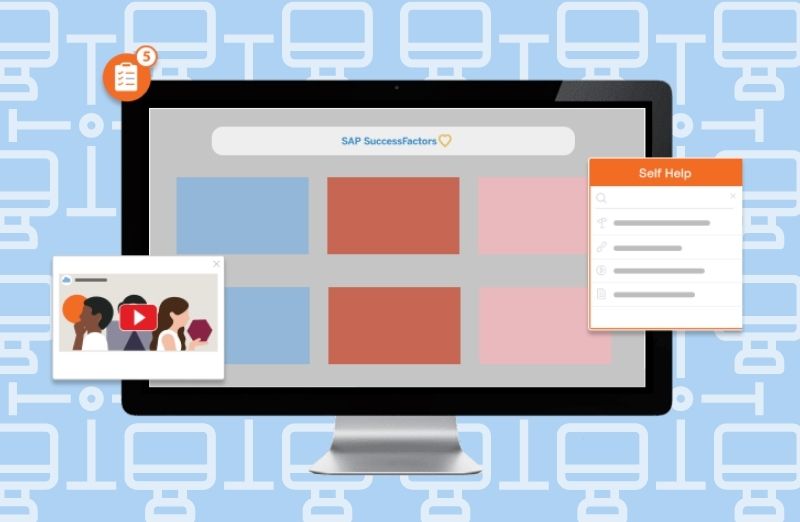
If you’ve ever led an implementation project before, you know roadblocks are common. Implementing a new HCM software such as SAP SuccessFactors has similar obstacles. You’re likely to face resistance to change, strained resources, data compliance and migration, possible downtime, and a lack of IT support during (and after) implementation.
However, overcoming these implementation challenges makes your SuccessFactors investment worth it, as SuccessFactors completely transform the way your HR department functions and digitally transforms your entire HR and talent management department.
That’s why SAP SuccessFactors is one of the market leaders in the human experience management (HXM) space. In Q4 2020 alone, 900 organizations adopted it to reimage how they manage their human resources operations.
With so many organizations implementing SAP SuccessFactors, there are bound to be challenges unique to each organization. But the most common challenges can be overcome by planning ahead, training your employees, utilizing resources effectively, and backing up your data.
What are the best practices for a successful SuccessFactors implementation project?
- Get buy-in from your HR team
- Create a SuccessFactors onboarding and training plan
- Define success and how you’ll measure it
- Decide how to allocate your resources for implementation
- Back up all data to reduce the risk of downtime or data loss
- Take all integrations into account
What Is SAP SuccessFactors?
SuccessFactors is an HCM software platform from SAP. Its platform is designed around a better employee experience, providing companies with employee self-service features to make previously transactional HR processes more human and intuitive.
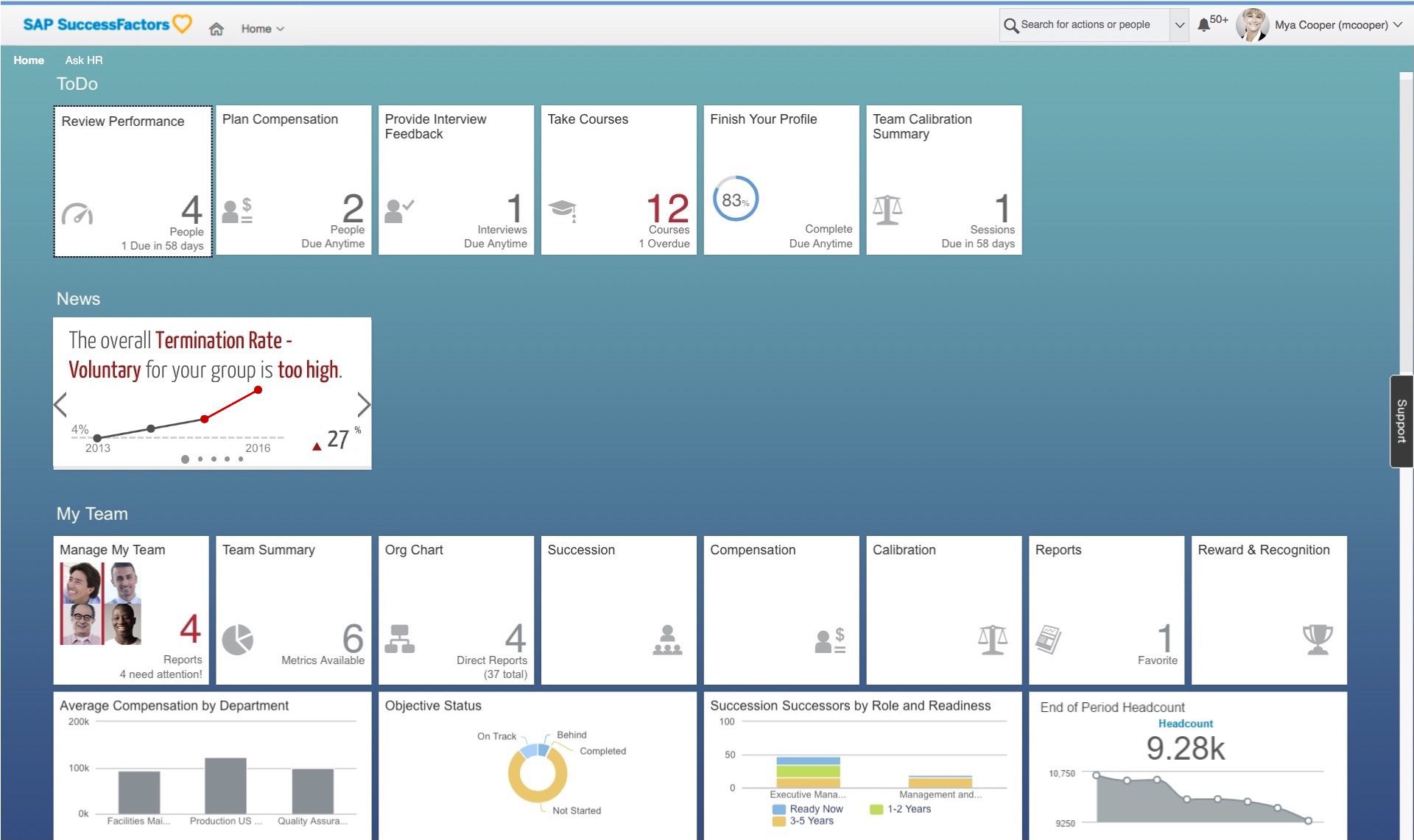
SuccessFactors helps HR digitally transform, with new processes to support employee experience management, payroll, benefits, talent management, HR analytics, and workforce planning.
6 Tips to Successfully Implement SAP SuccessFactors in 2024
Here are 6 best practices to follow to successfully implement your new SAP SuccessFactors investment for your organization.
1. Get buy-in from your HR team
When implementing new technology and replacing old systems, human resistance to change is the first hurdle to overcome. According to McKinsey, 70% of transformations fail. This is because the leaders do not take their team on board, and the employees do not have the right skill set to implement the new technology.
Your HR people are used to working with legacy systems. They are familiar with the user interfaces of these systems and may not want to switch to the new way of doing things. To get them on board, you will have to prove to them that the new way of doing things is better.

Start by having a series of meetings with them to address their questions. In these meetings, you can explain what SAP SuccessFactors is, why your organization needs it, how it will add value to your overall operations, the kind of training the team will need to use it, and the time it will save the team in performing their tasks.
You can also use this time with the team to showcase your plans for implementation and address their concerns about training, user roles, and the overall timeline of the change. You can also gather feedback from the team to better understand their concerns. For example, someone from the team may want to know how onboarding will work after the new system is implemented, someone else may have concerns over data structure and security, and so on.
2. Create a SuccessFactors onboarding and training plan
Sign your HR team up for SAP SuccessFactors training even before you begin the implementation process. This will familiarize them with the software and reduce the natural resistance to change that makes them want to stick to legacy systems.
According to a report by PwC, 34% of the workforce is interested in learning new technology out of sheer curiosity, and 37% would do it if it helps advance their career. By including your employees in this initiative, you acknowledge them as stakeholders and improve the chances of success by 22%.
You’ll not only need to support your workforce during SuccessFactors onboarding but also provide on-demand performance and IT support for your employees when they have SuccessFactors-related system questions.
With a digital adoption platform such as Whatfix, organizations can create in-app onboarding, training, and on-demand support content that helps guide users through the various functions of SuccessFactors, highlight important features, push employees to complete unfinished tasks, and embed self-help wikis to find answers important and answers to FAQs.
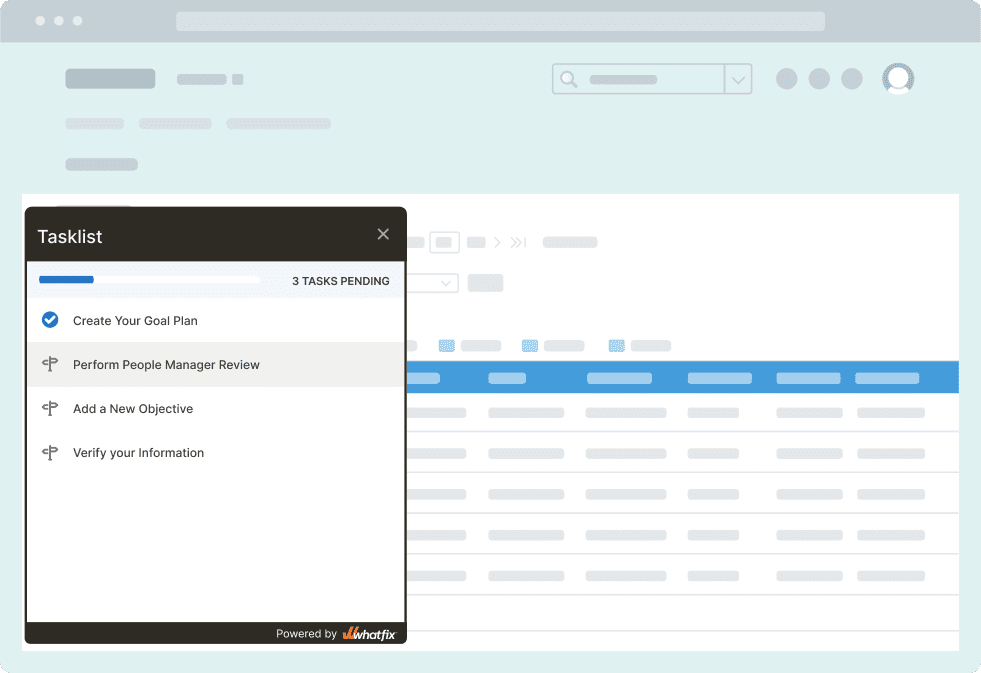
Above: Create in-app messaging for effective SuccessFactors onboarding and continuous on-demand support – helping to drive adoption and empower your workforce. Learn more about Whatfix for SuccessFactors now.
3. Define success and how you’ll measure it
Defining success and clearly communicating it to your team will give them a sense of purpose and direction as they’ll know exactly what they are working toward. As a rule of thumb, if the project is completed within budget and by the deadline and the new SuccessFactors module works as intended, your implementation project is a success.
It is a good idea to write down the scope of the SuccessFactors implementation project and clearly describe what success looks like. For example, “the onboarding process should become fully automated” gives everyone a clear idea of what things should look like once SuccessFactors is implemented.
You can also define success in terms of user adoption. Is everyone on the HR team using SuccessFactors without any issues? Has that increased efficiency? Were you able to save time otherwise spent on repetitive tasks? Did you successfully avoid downtime or data loss? Consider all of these factors when defining success, and make sure your definition of success is in line with your organization’s needs.
4. Decide how to allocate resources for implementation
SuccessFactors implementation requires a lot of time and resources. Careful planning about resource allocation can save you a lot of trouble down the road.
Here are a few points to consider when allocating your organization’s resources for implementing your new SuccessFactors investment:
Factor in the Number and Type of Modules You’ll Implement
There are SuccessFactors modules that deal with all aspects of human resource management, such as recruitment and onboarding, core HR and payroll operations, workforce planning, and talent management. Implementing different modules can take anywhere between three and 10 months.
The bigger modules, such as Employee Central and Payroll, take more time to implement. In the meantime, operations at your organization do not stop. This means that your HR team continues to work with legacy systems while taking on this new project of implementing a new technology. So factor in the number of hours you want them to dedicate to the implementation process.
Create an Agile Team with Cross-Departmental Stakeholders
Resource allocation, as well as project management, is easier with agile teams. Include people from your HR and IT departments on this team, and make sure everyone knows their responsibilities and their role in the project.
The size and structure of the team depend on the number and complexity of the modules you are trying to implement, but even on the smallest team, you will need a product owner to coordinate, keep everyone up to speed with roadblocks and challenges related to the project, and ensure that the team meets the deadlines.
You can hire a contractor for this role or choose someone from your team to do it. The idea is that you need one person to own the project. Creating an agile team will also help you manage conflicting priorities since you will have resources dedicated to the implementation project.
Allocate Time for Customization
Gather all requirements from members of the HR team who will use the new software, and calculate the amount of time needed for the added integrations and customization. The time needed for customization is in addition to the standard time needed to implement a module. Customization, in most cases, is unavoidable as your HR team could ask for custom views, dashboards, and reports that go with the processes at your organization.
Set Your Schedule and Adjust as Needed
After collecting all the requirements, your IT team (or the developers helping you with the implementation) will be able to calculate the time needed to complete the project. You can add more resources — such as developers and HR staff dedicated to the project — to complete the project at an accelerated timeline.
5. Back up all data to reduce the risk of downtime or data loss
Even smaller modules of SAP SuccessFactors take months to implement, and during that time, your organization will continue to generate and accumulate data. You’ll have to back up data so it can be ported over to the new HCM from your legacy systems without any data loss.
According to IDC, 43% of organizations suffered from irrecoverable data loss between 2020 and 2021, and 63% suffered data-related business disruptions. The reasons behind data loss include malware, human error, and data recovery system failure.
It’s a good idea to back up your data periodically throughout the implementation process using on-premises or cloud-based storage. You can use this seven-step data migration procedure:
- Valuate and audit the data. Look at the data type, structure, dependencies, and missing fields to determine a standard for the way the data is stored. For example, you may determine that certain categories should only be numeric in nature (such as phone numbers) and that certain categories are necessary for the entire set to be considered valid (such as employee ID).
- Identify key stakeholders. While the primary stakeholder is the HR department, your CEO, managers, and employees are also stakeholders when it comes to the HR database. It is a good idea to run some of the data parameters by the managers and leaders from every department.
- Establish data quality rules. This is necessary to identify both outdated and incomplete data. For example, some of the compliance certifications of your employees expire every few years, and it is easy for your database to show them as certified even after the expiry date. You can avoid this error by pulling datasets that were updated more than x years ago, and so on.
- Determine the data that should be archived. In the above three steps, you may identify older or incomplete data that may not be relevant anymore and should be archived. At this stage, you should also determine the data that should be backed up.
- Test the migration. Move a small set of data to a test environment and see how well the data from your legacy system is moving to your new HCM. This is the ideal stage to see if any data is being lost during the process.
- Move all data to the backup environment. If the test went smoothly, go ahead and complete the migration.
You can choose to migrate the data directly from your legacy system, but a safer way to do it is to back up the data and use your backup environment as the primary source of data for the migration. Once that is done, you can configure SuccessFactors to handle the data backup process for you in the future.
6. Take all integrations into account
Create a list of all integrations that will have to be built, and take them into account when setting a deadline for implementation. If you plan to only use a few modules from SAP SuccessFactors, they need to work with the rest of your HR ecosystem. If you plan to switch to SuccessFactors for all your HXM needs, you’ll be addressing compatibility with the rest of your technology stack, such as your learning management system (LMS), your customer relationship management system (CRM), and so on.
With the SuccessFactors Integration Center, your developers can build and test new inbound and outbound integrations. The good thing about these custom integrations is that SuccessFactors can pretty much be integrated with any other system used at your organization, from external application tracking systems to Microsoft Teams. The downside is that you will need the help of a developer (or multiple developers) for each integration. This means additional resources and costs based on the complexity of the integration.
You can rely on tools such as Boomi that serve as intermediaries between SuccessFactors and other applications. But this is a short-term workaround, not a permanent solution, since there’s a monthly cost for each integration you set up this way.
To fully find ROI from your SuccessFactors investment, you achieve organizational-wide adoption of the new HCM platform.
With Whatfix, create in-app guided content to help onboard and train your employees and managers on how to use the platform’s various features, as well as provide on-demand self-help support that provides answers to FAQs and links to external documents.
Ready to learn more? Explore Whatfix for SuccessFactors now!
Request a demo to see how Whatfix empowers organizations to improve end-user adoption and provide on-demand customer support
Thank you for subscribing!


